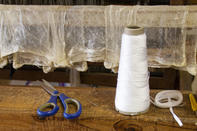Silk production originated in China. Legend has it that Empress Hsi Ling Shi, wife of Emperor Huang Ti, also known as the Yellow Emperor, discovered silk after a silkworm cocoon fell into her teacup. The empress was fascinated by the silk and is credited for domesticating the silkworm and inventing the reel and loom.

China kept secret the way in which silk was produced for nearly three millennia, with anyone trying to smuggle eggs, cocoons or silkworms out of the country immediately executed.
Merchants also had to travel the dangerous Silk Route, which stretched over 6 500 km miles from Eastern China to the Mediterranean through the Takla Makan desert and the Pamir mountain range to buy silk with most doing only certain parts of the journey.
Various theories exist on how the silk secret was broken. One holds that a Chinese princess smuggled eggs out with a hairpiece when she married a prince from another country. Another, that Chinese emigrants smuggled the eggs with them when they went to other Eastern countries.
The West caught on around the 550 C.E when the Byzantine emperor Justinian sent two monks to central Asia, who smuggled the eggs out in bamboo staves.
International Production
China still has the largest sericulture industry, followed by India. Small volumes are also produced in countries such as Korea, Thailand, and Brazil.
Local Production
Since the 1600s, different types of mulberry tree strains were brought into South Africa from Thailand, Taiwan, and Indonesia. In 1726, silkworms were brought into the country by the Dutch East India Company.
Silk was then produced by slaves and later on, an effort was made to create, free a slave sericulture project, close to Stellenbosch.
During the late 19th century, Italian sericulture experts came to South Africa in order to begin a silk industry at Gouna, which lies close to Knysna in the Western Cape. These settlers believed that they would be able to begin their farming immediately, however, in Gouna there were no mulberry trees, which meant that the settlers had to resort to farming and woodcutting in order to survive. The mulberry trees that were eventually planted expired due to the unfavourable growing conditions.
During the 1980s, the Department of Agriculture began a sericulture project in Mpumalanga. Many trials were performed to test the various mulberry tree species and production practices. In 1994, the mulberry project was assumed by the private sector after the government ceased funding due to the high financial costs and low returns.
Production
One of the only remaining sericulture farms in South Africa is located in Mpumalanga near Graskop. This farm had roughly 6 ha under mulberry trees in 2019.
The trees are pruned every 6 to 8 weeks into shrubs to ease production management.
The trees are sawn down to the ground during winter and then completely resprout in spring. No new trees have been planted on the farm since 1994 because of the invasive status of the trees.
Production Season
Whereas the silkworms kept by school children have up to two growth cycles, Africa Silk manipulates production to have a continuous supply of silk throughout the year. According to Ronel Swart, the owner of the company, the eggs are chilled to allow them to produce hatchings every second week.
Newly hatched silkworm larvae only receive young leaves because their jaws are not fully developed making it difficult for them to feed on older leaves. The worms are fed up to five times a day, depending on their stage of development. The larvae usually start spinning their cocoons around thirty days after being hatched.
It roughly takes a kilogram of feed to raise 50 silkworms, with one silkworm producing only about 0.2 kg of silk. This means that about 4761 cocoons is needed to produce roughly a kilogram of silk.
Varieties
Silk is produced by the Bombyx mori species, which is a domestic silkworm from the Bombycidae family. Other insects also produce silk, such as the Mopani worm in Africa, but the texture of this silk is different from that produced by the silkworm. Most of this silk is also harvested from the wild.
Sales
Africa Silk sells its processed silk locally and internationally, especially to Europeans.
Uses
Silk has a low density, making it ideal for light and comfortable clothing. It has excellent insulation properties, keeping you warm in winter and cool in summer, and is the strongest natural fibre available, which is why it is also used to make products like parachutes and bicycle tyres.
Silk filaments have antibacterial properties and are extensively used in the medical field to fabricate arterial and other prosthetics and to treat wounds and burns.